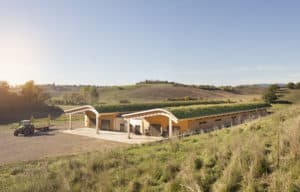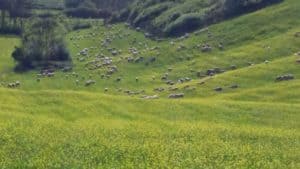I’ll get to the cheese, but first we have to talk a little about meat.
Originally a salami producer, SALCIS— an acronym for Societa Anonima Lavorazione Carni Insaccati Siena—was founded in 1941 during World War II as a way to unify all the Tuscan Salami producers in the area of Siena. The society is owned, to this day, by the family of one of the original founders, Armando Morbidi, and a number of Morbidi shops are still open in the city center of Siena. When the war ended, some associates continued with production and distributed their products outside of the city limits.
In the 1960s, the society began its ow n sheep dairy and ventured into production of Pecorino cheese. Then in 2000, the discrete pork butchery and dairy premise merged into a single new facility at the foot of the glorious and historical Monteriggioni Castle in Siena—a splendid landmark referenced in Dante’s Inferno: “On its circular parapets/Montereggione crowns itself with towers.”
n sheep dairy and ventured into production of Pecorino cheese. Then in 2000, the discrete pork butchery and dairy premise merged into a single new facility at the foot of the glorious and historical Monteriggioni Castle in Siena—a splendid landmark referenced in Dante’s Inferno: “On its circular parapets/Montereggione crowns itself with towers.”
An interesting bit of history, but I digress! Where was I? Ah, yes, cheese! That’s where we come in.
Rogers Collection now carries three of SALCIS Pecorinos: Monnalisa Pecorino Trebbione; Monnalisa Pecorino Foglie di Noce; and Monnalisa Pecorino Grottino (a side note that we carry only the small size 2 x 1kg of the Grottino).
Where to begin?
Well, I guess with the herd and the milk is a good place. SALCIS uses only sheep milk from herds in the countryside of Crete Senesi area. As with all of our farmstead cheeses, the milk goes into production no more than 24 hours later. Rennet and cultures are added to the milk in small vats, a technique that follows traditional craft processing.
Now, let’s talk about how the cheeses are made and, most importantly, how they taste.
The Trebbione is raw, so of course the sheep’s milk is transformed without pasteurizing. Keeping the milk raw is a process which preserves the natural flora and bacteria as well as flavor.
Sounds simple enough, right? Well, not really. The milk for this particular processing is selected by following microbiologic parameters regarding hygiene and health of the sheep’s milk. And you can’t just use any milk produced by the sheep—the Trebbione requires milk that has specific qualities found only during certain times of the sheep’s lactation.
Okay, so now for the flavor and the best way to eat this raw-milk Trebbione. The robust, strong personality of this raw sheep’s milk Pecorino calls for a full-bodied red wine—try Brunello di Montalcino.
That’s it: cheese and wine. I mean, do we need any more than that!
Now for the Monnalisa Pecorino Foglie di Noce (ripened in walnut leaves). This aging method is a long-standing tradition that uses walnut leaves to preserve Pecorino during the warm months. The leaves’ protection allows the cheeses to age slowly, imbuing it with strong flavors that are reminiscent of SALCIS’ forefathers’ cheeses—a method and flavor long forgotten among many other Pecorinos.
Accompaniment suggestions are pretty simple—as most delicious things are: honey! Certainly, you could toss a little wine in a glass to go with this.
Many things get better and more complex with age and of course cheese is one of them.
Monnalisa Pecorino Grottino (cave ripened) is made by selecting the best cheeses approximately 60 days after processing and moving them into natural caves of rock and tuff. Then the cheeses are treated with linseed oil and set to rest on pine wood shelves. Next, each cheese is monitored and turned at least once a week. The cave’s natural climate allows the Pecorino to age slowly, creating its distinct, robust flavor. The crust acquires a deep rust color while the cheese inside is white and dense with a tendency to crumble perfectly. A Chianti Classico DOCG would not be a shabby pairing with this cheese.
Not too shabby at all, friends.
Rogers Collection is really excited to add these three fine Pecorinos to our catalog.
Perhaps Monteriggioni Castle—site of these divine cheeses—would have been better referenced in Dante’s Paradiso rather than his Inferno.
Regardless of the literary reference, these cheeses are indeed a little slice of heaven.
Written by Leska Tomash